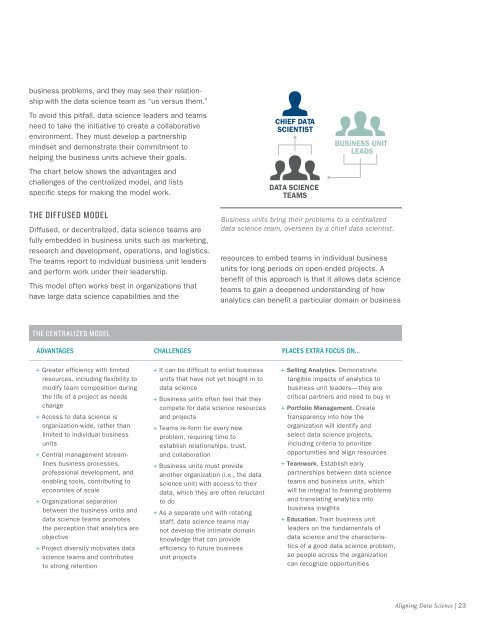Tips for Building a Data Science Capability
1MRbAqC
1MRbAqC
Create successful ePaper yourself
Turn your PDF publications into a flip-book with our unique Google optimized e-Paper software.
usiness problems, and they may see their relationship<br />
with the data science team as “us versus them.”<br />
To avoid this pitfall, data science leaders and teams<br />
need to take the initiative to create a collaborative<br />
environment. They must develop a partnership<br />
mindset and demonstrate their commitment to<br />
helping the business units achieve their goals.<br />
The chart below shows the advantages and<br />
challenges of the centralized model, and lists<br />
specific steps <strong>for</strong> making the model work.<br />
CHIEF DATA<br />
SCIENTIST<br />
DATA SCIENCE<br />
TEAMS<br />
BUSINESS UNIT<br />
LEADS<br />
THE DIFFUSED MODEL<br />
Diffused, or decentralized, data science teams are<br />
fully embedded in business units such as marketing,<br />
research and development, operations, and logistics.<br />
The teams report to individual business unit leaders<br />
and per<strong>for</strong>m work under their leadership.<br />
This model often works best in organizations that<br />
have large data science capabilities and the<br />
Business units bring their problems to a centralized<br />
data science team, overseen by a chief data scientist.<br />
resources to embed teams in individual business<br />
units <strong>for</strong> long periods on open-ended projects. A<br />
benefit of this approach is that it allows data science<br />
teams to gain a deepened understanding of how<br />
analytics can benefit a particular domain or business<br />
THE CENTRALIZED MODEL<br />
ADVANTAGES CHALLENGES PLACES EXTRA FOCUS ON…<br />
+ Greater efficiency with limited<br />
resources, including flexibility to<br />
modify team composition during<br />
the life of a project as needs<br />
change<br />
+ Access to data science is<br />
organization-wide, rather than<br />
limited to individual business<br />
units<br />
+ Central management streamlines<br />
business processes,<br />
professional development, and<br />
enabling tools, contributing to<br />
economies of scale<br />
+ Organizational separation<br />
between the business units and<br />
data science teams promotes<br />
the perception that analytics are<br />
objective<br />
+ Project diversity motivates data<br />
science teams and contributes<br />
to strong retention<br />
+ It can be difficult to enlist business<br />
units that have not yet bought in to<br />
data science<br />
+ Business units often feel that they<br />
compete <strong>for</strong> data science resources<br />
and projects<br />
+ Teams re-<strong>for</strong>m <strong>for</strong> every new<br />
problem, requiring time to<br />
establish relationships, trust,<br />
and collaboration<br />
+ Business units must provide<br />
another organization (i.e., the data<br />
science unit) with access to their<br />
data, which they are often reluctant<br />
to do<br />
+ As a separate unit with rotating<br />
staff, data science teams may<br />
not develop the intimate domain<br />
knowledge that can provide<br />
efficiency to future business<br />
unit projects<br />
+ Selling Analytics. Demonstrate<br />
tangible impacts of analytics to<br />
business unit leaders—they are<br />
critical partners and need to buy in<br />
+ Portfolio Management. Create<br />
transparency into how the<br />
organization will identify and<br />
select data science projects,<br />
including criteria to prioritize<br />
opportunities and align resources<br />
+ Teamwork. Establish early<br />
partnerships between data science<br />
teams and business units, which<br />
will be integral to framing problems<br />
and translating analytics into<br />
business insights<br />
+ Education. Train business unit<br />
leaders on the fundamentals of<br />
data science and the characteristics<br />
of a good data science problem,<br />
so people across the organization<br />
can recognize opportunities<br />
Aligning <strong>Data</strong> <strong>Science</strong> | 23


